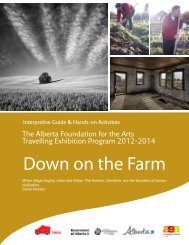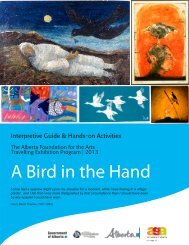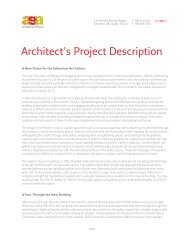Urban Animals - Art Gallery of Alberta
Urban Animals - Art Gallery of Alberta
Urban Animals - Art Gallery of Alberta
Create successful ePaper yourself
Turn your PDF publications into a flip-book with our unique Google optimized e-Paper software.
The <strong>Alberta</strong> Foundation for the <strong>Art</strong>s Travelling Exhibition Program<br />
Glossary continued<br />
Iconography: A set <strong>of</strong> specified or traditional symbolic forms associated with the subject or<br />
theme <strong>of</strong> a stylized work <strong>of</strong> art.<br />
Impressionist: A theory or style <strong>of</strong> painting originating and developed in France during the<br />
1870s, characterized by concentration on the immediate visual impression produced by a scene<br />
and by the use <strong>of</strong> unmixed primary colors and small strokes to simulate actual reflected light.<br />
Mythology: The body <strong>of</strong> myths (sacred stories) <strong>of</strong> a particular culture, or <strong>of</strong> humankind as a<br />
whole; the study and interpretation <strong>of</strong> such myths.<br />
Organic shapes: An irregular shape; refers to shapes or forms having irregular edges or<br />
objects resembling things existing in nature.<br />
Pop <strong>Art</strong>: A 20th century art style focusing on mass-produced urban culture: movies, advertising,<br />
science fiction. In the USA Pop <strong>Art</strong> was initially regarded as a reaction from Abstract<br />
Expressionism because its exponents brought back figural imagery and made use <strong>of</strong> hardedged,<br />
quasi-photographic techniques. Pop artists employed commercial techniques in<br />
preference to the painterly manner <strong>of</strong> other artists.<br />
Positive shapes: Are the objects themselves. They are surrounded in a painting by what are<br />
called the negative shapes or spaces.<br />
Primary colours: The three colours from which all other colours are derived - red, yellow and<br />
blue.<br />
Shade: Add black to a colour to make a shade. Mix the pure colour with increasing quantities <strong>of</strong><br />
black making the colour darker in small increments. If you add gray to a colour, you produce a<br />
tone.<br />
Symbolism: The practice <strong>of</strong> representing things by means <strong>of</strong> symbols or <strong>of</strong> attributing symbolic<br />
meanings or significance to objects, events, or relationships.<br />
Tint: Add white to a colour to create a tint. Mix the pure colour with increasing quantities <strong>of</strong><br />
white so that the colour lightens.<br />
Warm colours: Yellow and reds <strong>of</strong> the colour spectrum, associated with fire, heat and sun. In<br />
aerial perspective warm colours are said to come towards you.<br />
Woodland Style: Is a genre <strong>of</strong> graphic design and painting among First Nations artists from the<br />
Great Lakes area - including northern Ontario and southwestern Manitoba. Founded by Norval<br />
Morrisseau, this visionary style emphasizes outlines and x-ray views <strong>of</strong> people, animals, and<br />
plant life using vivid colour.<br />
AFA Travelling Exhibition Program, Edmonton, AB. Ph: 780.428.3830 Fax: 780.421.0479<br />
youraga.ca

















